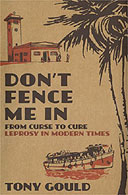
Don't Fence Me In: Leprosy In Modern Times
by Tony Gould
432pp, Bloomsbury, £20
Leprosy is an ancient disease, familiar from the Bible as well as Shakespeare, but the focus of Tony Gould's excellent book is the past 200 years, during which scientific knowledge and medical treatment have developed spectacularly, but fearful social attitudes have persisted. Only in 2001 did Japan repeal its laws requiring compulsory detention of leprosy patients.
Gould's sympathies, very properly, lie mainly with those affected by the disease, but he writes understandingly of the problems faced by doctors, nurses and administrators. While being alert to imperialist and colonialist attitudes - some missionaries have appeared more than half in love with suffering - he does not use these simply to damn the practices of the past. That a particular doctor or missionary had faults and attitudes unpopular today does not obviate the good of his or her work entirely.
Some leprosy advocates have argued that the Bible is the source of much anti-leprosy prejudice; Gould shows, however, that the horror of leprosy is as strong if not stronger in non Judaeo-Christian cultures. Moreover, as one missionary doctor pointed out: "When no one else cared or bothered, Christians did, and their example still inspires those of other faiths and of no faith." Even the 20th-century pioneers of leprosy treatment and research - such as Paul Brand, born into a missionary family in India, and Stanley Browne, known as "the boy preacher" in his Bermondsey youth - came from the medical missionary tradition.
The title of Brand's book, Pain: The Gift Nobody Wants, indicates his great realisation: the importance, indeed the blessing, of pain. In leprosy, the loss of digits and limbs results from impaired pain sensation rather than the disease itself. Most people will, for example, adjust painful shoes and thus prevent blisters and the risk of infection; those with impaired pain sensation, such as leprosy patients, don't. This understanding, with the use of sulphone drugs from the 1940s, revolutionised the treatment and management of the disease.
The most famous figure in the history of leprosy is Father Damien of Molokai. The death of "this stubborn, self-sacrificing peasant-priest" in 1889 caught the imagination of the public worldwide. Robert Louis Stevenson defended the memory of Damien against rival clerics, and leprosy had a modern martyr and figurehead for fundraising.
Leprosy has been associated with a succession of colourful characters, from Kate Marsden, the English nurse whose mission to Siberia took her across thousands of miles "by sledge and horseback", to Stanley Stein, the Jewish pharmacist from Texas who became the "Carville Crusader" (Carville in Louisiana was the only leprosarium in the continental United States); Gould describes them with evident admiration, while recognising that they could be maddening and stubborn as well.
Stein edited the extraordinary leprosy patients' publication the Star, and was the scourge of the US Public Health Service. He loathed the words "leper" and "leprosy", preferring the term Hansen's disease. Ironically the Norwegian Hansen, who discovered the Mycobacterium leprae bacillus, was a firm advocate of the isolation measures Stein campaigned against. Gould abjures "leper" ("it's now impossible to use it ... without giving offence"), but finds himself unable to abandon the term "leprosy" itself.
Writing in a lively, engaging style capable of encompassing the intricacies of medical politics, he gives a real sense of what it meant to be a patient with leprosy well into the 20th century - the feeling of being an outcast, something otherworldly and not quite human. The patients at Carville were indefatigable in battling this, adopting the Cole Porter song "Don't Fence Me In" as their anthem - hence the book's title.
Much remains unknown about leprosy. One of the saddest ironies of the disease is that it is not nearly as communicable as commonly believed. It is not spread by touch, as it lacks enzymes to penetrate intact skin. Even now, the exact mode of transmission is unknown and some recent researchers have gone so far as to suggest that Mycobacterium leprae is not the causative agent but an opportunistic pathogen. My medical education taught me that the nine-banded armadillo was the only other species that could be infected with leprosy. However the New World sooty mangabey monkey shares the honour.
Leprosy, Gould concludes, has not gone away. In the United States 300 to 500 cases occur annually. And around the world - in Nepal, in India, in Indonesia and sub-Saharan Africa - the incidence of the disease remains constant. The WHO has assigned 2005 as the year of the final elimination of leprosy, although "elimination" here means fewer than 1 case per 10,000 population in all endemic countries. There is an element of statistical chicanery to this, as other measures would give a more accurate picture of the extent of the illness. Furthermore, the WHO recognises lack of bacterial infectivity as cure, rather than the lack of longer-term effects. Gould writes that many leprosy workers are highly suspicious of the "elimination" enterprise, worrying that the WHO's grandiloquent goal is more about meeting targets than the welfare of those who have this misunderstood condition.
· Seamus Sweeney is a doctor and contributor to Meet the Philosophers of Ancient Greece (Ashgate, 2005).

